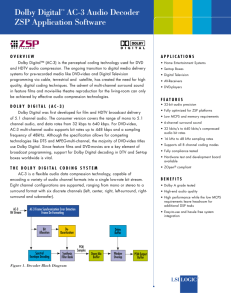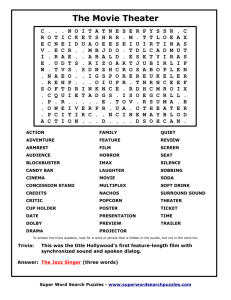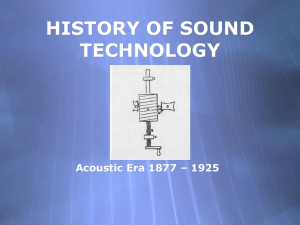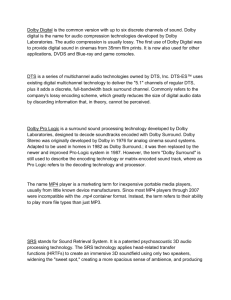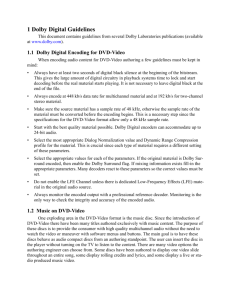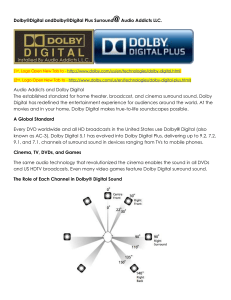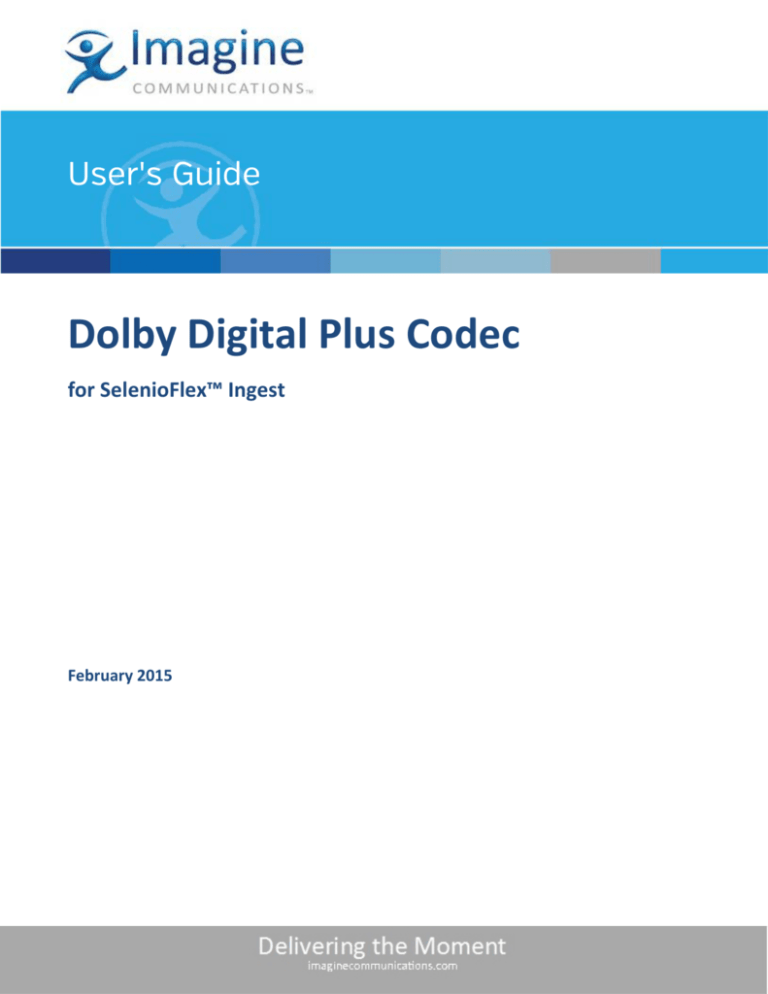
User's Guide
Dolby Digital Plus Codec
for SelenioFlex™ Ingest
February 2015
Dolby Digital Plus Codec for SelenioFlex™ Ingest
User's Guide
Publication Information
© 2015 Imagine Communications Corp.
Proprietary and Confidential.
Imagine Communications considers this document and its contents to be proprietary and confidential.
Except for making a reasonable number of copies for your own internal use, you may not reproduce this
publication, or any part thereof, in any form, by any method, for any purpose, or in any language other
than English without the written consent of Imagine Communications. All others uses are illegal.
This publication is designed to assist in the use of the product as it exists on the date of publication of
this manual, and may not reflect the product at the current time or an unknown time in the future. This
publication does not in any way warrant description accuracy or guarantee the use for the product to
which it refers. Imagine Communications reserves the right, without notice to make such changes in
equipment, design, specifications, components, or documentation as progress may warrant to improve
the performance of the product.
Trademarks
Stream™, Stream Live™, SelenioFlex™ Ingest, and SelenioFlex™ are trademarks or trade names of
Imagine Communications or its subsidiaries.
Microsoft® and Windows® are registered trademarks of Microsoft Corporation. All other trademarks and
trade names are the property of their respective companies.
Dolby and the double-D symbol are trademarks of Dolby Laboratories. Notice about Dolby Digital Plus
Professional Encoder in Imagine Communications Stream: Confidential unpublished works. Copyright
2003–2007 Dolby Laboratories. All rights reserved.
Contact Information
Imagine Communications has office locations around the world. For domestic and international location
and contact information, visit our Contact page
(http://www.imaginecommunications.com/company/contact-us.aspx).
Support Contact Information
For domestic and international support contact information see:
•
•
•
Support Contacts (http://www.imaginecommunications.com/services/customer-care.aspx)
eCustomer Portal (http://support.imaginecommunications.com)
Academy Training (http://www.imaginecommunicationsacademy.com)
© 2015 Imagine Communications Corp.
Proprietary and Confidential.
| Page 2
Dolby Digital Plus Codec
User's Guide
Contents
Contents
Dolby Digital Plus Codec Profile Settings ................................................................ 4
Audio Encoder Configuration ................................................................................................................... 5
Preprocessing ........................................................................................................................................... 6
Metadata .................................................................................................................................................. 8
Bitstream Info ......................................................................................................................................... 10
Mixing Metadata .................................................................................................................................... 12
© 2015 Imagine Communications Corp.
Proprietary and Confidential.
| Page 3
Dolby Digital Plus Codec
User's Guide
Dolby Digital Plus Codec Profile Settings
Dolby Digital Plus Codec Profile
Settings
The Dolby Digital Plus codec profile in Imagine Communications SelenioFlex Ingest can be used to save
all of the settings used when encoding Dolby Digital Plus (EC-3) audio. Depending on your license you
will be authorized for Stereo only (one or two channels) or Surround (one to 5.1 channels), and for file
based encoding only or file based and live (broadcast output). This codec can be used to create
elementary stream audio files.
© 2015 Imagine Communications Corp.
Proprietary and Confidential.
| Page 4
Dolby Digital Plus Codec
User's Guide
Dolby Digital Plus Codec Profile Settings
Audio Encoder Configuration
Number of Channels: Shown as two numbers, m/n, with m indicating the number of front channels and
n indicating the number of rear (surround) channels.
LFE Enable: The LFE channel (Low-Frequency Effects Channel) is only available when more than two
channels have been selected.
Data Rate: The data rates that you can select (based on the number of channels that you have set) will
be shown in the drop-down box. When you first select a new "Number of Channels" setting the data
rate shown will be the optimum data rate for that number of channels.
There is also an Auto setting. When this is enabled the codec will always use the optimum data rate for
the selected number of channels.
© 2015 Imagine Communications Corp.
Proprietary and Confidential.
| Page 5
Dolby Digital Plus Codec
User's Guide
Dolby Digital Plus Codec Profile Settings
Sampling Frequency: The codec supports 3 sampling frequencies: 32, 44.1, 48 kHz. There is also an
option for "Auto (match input)" which will set the sample frequency to match the sampling rate of the
live input or of the media file that is being transcoded.
Create stand alone EC-3 file (convert to little endian): Activating this feature changes the endian of the
encoded bitstream. Whether big or little endian should be used is determined by the player that will be
used to decode the file.
Both endians can be used to create an EC-3 stand alone file or when creating an EC-3 file for muxing (in
an MP4 file or TS file, for example). Most MP4 players will only decode an MP4 file containing EC-3 if the
"Create stand alone EC-3 file" option is checked. When the file is muxed into a Transport Stream file
using the Manzanita muxer the muxer will always convert the EC-3 file to big endian.
Preprocessing
This window shows the options the codec can use to process the audio input signals before they are
encoded.
© 2015 Imagine Communications Corp.
Proprietary and Confidential.
| Page 6
Dolby Digital Plus Codec
User's Guide
Dolby Digital Plus Codec Profile Settings
DC 3 Hz Highpass Filter for all channels: The DC component of an audio signal is perceptually irrelevant.
When this option is enabled a DC blocking 3 Hz highpass filter is applied to all channels, and the codec
can then avoid having to spend bits to encode the DC component. It is recommended that this filter be
enabled.
Lowpass Filter for main channels (below full bandwidth): This setting activates a lowpass filter with a
cutoff near the full audio bandwidth that is applied to the main input channels (all channels in use
except the LFE channel). The full audio bandwidth is determined by the codec, and is determined by the
number of channels and the sample rate. With the exception of low bandwidth encodes, the full audio
bandwidth is normally around 20 kHz, so frequencies above that are generally noise.
120 Hz Lowpass Filter for LFE channel: This setting activates a 120 Hz lowpass filter applied to the LFE
input channel. Since this channel is only intended for low frequency effects, this should normally be
enabled.
This setting is available only when the LFE channel is enabled.
90 Degree Phase Shift on surround channels: This parameter can be used to apply a 90‐degree phase
shift on the surround channels at the input. This feature is useful for generating multichannel Dolby
Digital bitstreams that can be downmixed in an external two‐channel decoder to create an output
compatible with Dolby Surround.
This is available only when surround channels are present (that is, when the number of audio channels
has been set to 2/1, 2/2, 3/1, or 3/2).
3dB decrease applied to the surround channels: This parameter is used to apply a 3dB cut to the
surround channels of a multichannel film soundtrack when it is being transcoded into a format for
consumer home theater playback.
Cinema soundtrack surround channels are mixed 3 dB hot relative to the front channels to account for
cinema amplifier gains. Home theater surround channel gains are calibrated differently, so that is why a
–3 dB adjustment to the surround tracks is necessary when transcoding from one format to the other.
This is available only when surround channels are present (that is, when the number of audio channels
has been set to 2/1, 2/2, 3/1, or 3/2).
© 2015 Imagine Communications Corp.
Proprietary and Confidential.
| Page 7
Dolby Digital Plus Codec
User's Guide
Dolby Digital Plus Codec Profile Settings
Metadata
Enable External Metadata:
Metadata may be provided to the encoder using the settings in the codec profile (as detailed in the
following sections), or it may be input using a RS-485 serial data stream from an upstream device. If you
enable the external metadata option, the Ext. Metadata button will become active.
The external metadata settings window allows you to set:
•
•
•
•
Program Number (up to 8 programs may be available in the external metadata bitstream)
Reversion Mode (determines the source of metadata the encoder uses in case the external
metadata input fails.)
Metadata Overwrite (indicates if any external metadata should be overwritten by the settings
defined in the codec profile)
Comm Port (selects the RS-232 serial port on the computer being used to receive the external
metadata)
Bitstream Mode: This setting indicates the type of service that the bitstream conveys.
Bitstream Mode Setting
Definition
Complete Main (CM)
Complete Main flags the bitstream as the main audio service for the program
and indicates that all elements are present to form a complete audio
program. Currently, this is the most common setting. The CM service may
contain from one (mono) to six (5.1) channels.
Main Music and Effects (ME) This bitstream is the main audio service for the program, minus a dialogue
channel. The dialogue channel, if any, is intended to be carried by an
© 2015 Imagine Communications Corp.
Proprietary and Confidential.
| Page 8
Dolby Digital Plus Codec
User's Guide
Dolby Digital Plus Codec Profile Settings
associated dialogue service. Different dialogue services can be associated
with a single ME service to support multiple languages.
Associated Visual Impaired
(VI)
This is typically a single-channel program intended to provide a narrative
description of the picture content to be decoded along with the main audio
service. The VI service may also be a complete mix of all program channels,
comprising up to six channels.
Associated Hear Impaired
(HI)
This is typically a single-channel program intended to convey audio that has
been processed for increased intelligibility and decoded along with the main
audio service. The HI service may also be a complete mix of all program
channels, comprising up to six channels.
Associated Dialogue (D)
This is typically a single-channel program intended to provide a dialogue
channel for an ME service. If the ME service contains more than two
channels, the D service is limited to only one channel; if the ME service is
two channels, the D service can be a stereo pair. The appropriate channels of
each service are mixed together (requires special decoders).
Associated Commentary (C)
This is typically a single-channel program intended to convey additional
commentary that can be optionally decoded along with the main audio
service. This service differs from a dialogue service because it contains an
optional, rather than a required, dialogue channel. The C service may also be
a complete mix of all program channels, comprising up to six channels.
Associated Emergency (E)
This is a single-channel service that is given priority in reproduction. When
the E service appears in the bitstream, it is given priority in the decoder and
the main service is muted.
Associated Voice Over (VO)
This is a single-channel service intended to be decoded and mixed to the
Center channel (requires special decoders).
Main Service Karaoke (K)
This bitstream is a special service for karaoke playback. In this case, the Left
and Right channels contain music, the Center channel has a guide melody,
and the Left and Right Surround channels carry optional backing vocals.
Dialogue Normalization: This setting indicates how far the average dialogue level of the encoded
program is below digital full scale. Valid values are 1 to 31, which are interpreted as –1 to –31 dB with
respect to digital full scale. For example, movie soundtracks typically have a dialogue normalization
value of –27 dBFS. The difference between –27 dB and –31 dB is 4 dB. Dialogue normalization would
therefore attenuate the soundtrack on decode by 4 dB.
Typical values:
Action Film (5.1): -27 dB
Drama (Lt/Rt): -27 dB
Local News (Mono): -20 dB
© 2015 Imagine Communications Corp.
Proprietary and Confidential.
| Page 9
Dolby Digital Plus Codec
User's Guide
Dolby Digital Plus Codec Profile Settings
Music (5.0): -15 dB
Live Sporting Events (5.0): -18 dB
Dynamic Range Control (DRC): This setting is used to carry information about the dynamic range of the
encoded audio which may optionally be used by a Dolby Digital decoder user to reduce the dynamic
range of the decoded audio.
The DRC characteristic can be controlled by selecting one of the built‐in presets.
0 = no compression
1 = film standard compression
2 = film light compression
3 = music standard compression
4 = music light compression
5 = speech compression
Bitstream Info
The Bitstream Info is metadata added to the datastream.
© 2015 Imagine Communications Corp.
Proprietary and Confidential.
| Page 10
Dolby Digital Plus Codec
User's Guide
Dolby Digital Plus Codec Profile Settings
Dolby Surround EX Mode: The Dolby Digital Surround EX™ mode setting indicates whether the Dolby
Digital bitstream is conveying program material encoded in Dolby Digital Surround EX. This setting is
available only when the number of audio channels is set to 2/2 or 3/2.
Dolby Surround Mode: This setting indicates to a Dolby Digital decoding product that also contains a
Dolby Pro Logic decoder (for example, a 5.1-channel amplifier) whether or not the two-channel encoded
bitstream contains a Dolby Surround (Lt/Rt) program that requires Dolby Pro Logic decoding. Decoders
can use this flag to switch on Dolby Pro Logic decoding automatically as required. This setting is only
available when stereo has been selected (2/0).
Original Bitstream: When this setting is enabled it indicates that the bitstream is the original and not a
copy.
Copyright Bit: When this setting is enabled it indicates that the encoded audio is protected by copyright.
Peak Mixing Level: The mixing level setting indicates the acoustic sound pressure level of the dialogue
level during the final audio mixing session. The valid range is 80 to 111 dB SPL.
Room Type: The room type setting indicates the type and calibration of the mixing room used for the
final audio mixing session. The room type may be used by other parts of the audio reproduction
equipment.
A/D Converter: This setting indicates the type of technologies used in the A/D conversion process when
capturing PCM samples. Available values for A/D Converter:
•
•
Standard or unknown sampling technologies
Microsoft® HDCD® technology
© 2015 Imagine Communications Corp.
Proprietary and Confidential.
| Page 11
Dolby Digital Plus Codec
User's Guide
Dolby Digital Plus Codec Profile Settings
Mixing Metadata
The Mixing Metadata is added to the datastream according to the settings selected.
Notes:
Lt/Rt is a downmix suitable for decoding with a Dolby Pro Logic surround sound device. (t = total)
Lo/Ro is a downmix suitable for stereophonic sound playback on a hi-fi or on headphones. (o = only)
Stereo Downmix Preference: This setting indicates Lt/Rt downmix preferred, Lo/Ro downmix preferred,
or Not indicated. This setting is available only when the number of audio channels is set to 3/0, 2/1, 3/1,
or 3/2.
Lt/Rt Center Mix: This setting indicates the nominal downmix level of the Center channel with respect
to the Left and Right channels in an Lt/Rt downmix. This setting is available only when the number of
audio channels is set to 3/0, 3/1, or 3/2.
Lt/Rt Surround Mix: The Lt/Rt surround mix level setting indicates the nominal downmix level of the
surround channels with respect to the Left and Right channels in an Lt/Rt downmix. This setting is
available only when the number of audio channels is set to 2/1, 2/2, 3/1, or 3/2.
Lo/Ro Center Mix: The Lo/Ro Center mix level setting indicates the nominal downmix level of the Center
channel with respect to the Left and Right channels in an Lo/Ro downmix. This setting is available only
when the number of audio channels is set to 3/0, 3/1, or 3/2.
Lo/Ro Surround Mix: The Lo/Ro surround mix level parameter indicates the nominal downmix level of
the surround channels with respect to the Left and Right channels in an Lo/Ro downmix. This setting is
available only when the number of audio channels is set to 2/1, 2/2, 3/1, or 3/2.
© 2015 Imagine Communications Corp.
Proprietary and Confidential.
| Page 12

